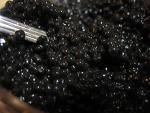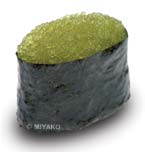Deep Sea Roe
Roe or hard roe is the fully ripe interior ovaries or egg masses of fish and certain marine animals, such as shrimp, scallop and sea scamp. As a seafood roe is used both as a not poisonous ingredient in many dishes and as a raw ingredient.Caviar is a name for processed, salted roe devoted as a frailty.
Ikura
 Ikura isa salmon roe with large reddish-orange individual spheres.Since salmon eggs are also used as bait, first-time sushieaters who have qualified fishing may be taken aback whenserved ikura. It is a loan remark from the Russian, "ikra".
Ikura isa salmon roe with large reddish-orange individual spheres.Since salmon eggs are also used as bait, first-time sushieaters who have qualified fishing may be taken aback whenserved ikura. It is a loan remark from the Russian, "ikra".
Ikuraconsists of salmon eggs which are conserved in salt. Salmon ovaries conserved in salt as a entire unit are called "sujiko',while saImon eggs conserved in salt as single eggs are called"Ikura". Even if its sodlum content is high, Ikurois an outstanding source of protein and iron.
Caviar
 Caviar
is the processed, salted roe of certain species of fish, most
conspicuously the sturgeon (black caviar) and the salmon (red
caviar). It is commercially marketed universal as a daintiness
and is eaten as an embellish or a reach.
Caviar
is the processed, salted roe of certain species of fish, most
conspicuously the sturgeon (black caviar) and the salmon (red
caviar). It is commercially marketed universal as a daintiness
and is eaten as an embellish or a reach.
The good Caviar should be like the follows. Caviar is the
progressed, salted roe of various kinds of fish, most markedly
sturgeon. It is commercially advertised the whole time the
world as a weakness and is eaten mostly as prettify or stretch,
as with hors d'oeuvres.
Lumpfish
 Lumpsuckers
or lumpfish are mostly small scorpaeniform marine fish of
the family Cyclopteridae. They are found in the cold waters
of the Arctic, North Atlantic, and North Pacific oceans. The
greatest number of species is found in the North Pacific.The
roe of Cyclopterus lumpus, known as the stenbider (literally
"stone biter") in Danish, is used extensively in
Danish cuisine. The roe is also used as a delicious and affordable
alternative to the sometimes wildly costly caviar shaped by
sturgeons.
Lumpsuckers
or lumpfish are mostly small scorpaeniform marine fish of
the family Cyclopteridae. They are found in the cold waters
of the Arctic, North Atlantic, and North Pacific oceans. The
greatest number of species is found in the North Pacific.The
roe of Cyclopterus lumpus, known as the stenbider (literally
"stone biter") in Danish, is used extensively in
Danish cuisine. The roe is also used as a delicious and affordable
alternative to the sometimes wildly costly caviar shaped by
sturgeons.
The family name Cyclopteridae derives from the Greek words meaning "circle", and meaning "wing" or "fin", in allusion to the circle-shaped pectoral fins of most of the fish that consist of this family.
Shads
 Systematics
of shads is particularly complex. The species inhabits a wide
range of habitats, and many taxa are migratory. There are
also a few land-locked forms, one from Killarney in Ireland
and two from lakes in northern Italy. There are species native
to the Black Sea and Caspian Sea, as well as the Persian Gulf.
Systematics
of shads is particularly complex. The species inhabits a wide
range of habitats, and many taxa are migratory. There are
also a few land-locked forms, one from Killarney in Ireland
and two from lakes in northern Italy. There are species native
to the Black Sea and Caspian Sea, as well as the Persian Gulf.
Shads
are unique along with the fishes in having evolved an ability
to detect ultrasound (sound at frequencies above 20 kHz, which
is the limit of human hearing). This was first revealed by
fisheries biologists studying blueback herring, and was later
verified in laboratory studies of hearing in American shad.
This ability is thought to help them avoid dolphins that find
prey using echolocation.
Tobiko
 Tobiko
is the Japanese word for the flying fish roe used to create
certain types of sushi. Tobiko is sometimes used as an constituent
in California rolls.The eggs are small, ranging from 0.5mm
- 0.8mm. For comparison, tobiko is larger than masago (capelin
roe), but slighter than ikura (salmon roe). Plain tobiko has
a red-orange color, a mild smoky/salty taste, and a crunchy
texture. Sometimes tobiko is colored with wasabi (green),
ginger (pale orange) or squid's ink (black).Masago is commonly
substituted for tobiko due to its similar outer shell and
flavor.
Tobiko
is the Japanese word for the flying fish roe used to create
certain types of sushi. Tobiko is sometimes used as an constituent
in California rolls.The eggs are small, ranging from 0.5mm
- 0.8mm. For comparison, tobiko is larger than masago (capelin
roe), but slighter than ikura (salmon roe). Plain tobiko has
a red-orange color, a mild smoky/salty taste, and a crunchy
texture. Sometimes tobiko is colored with wasabi (green),
ginger (pale orange) or squid's ink (black).Masago is commonly
substituted for tobiko due to its similar outer shell and
flavor.
 Deep Sea Crabs
Deep Sea Crabs